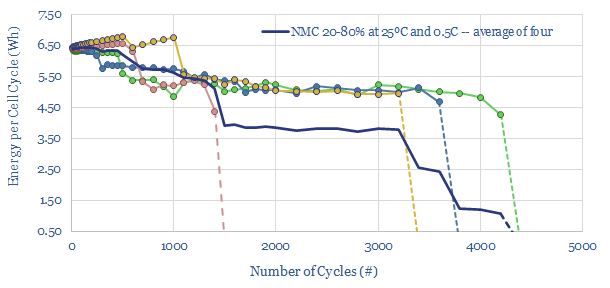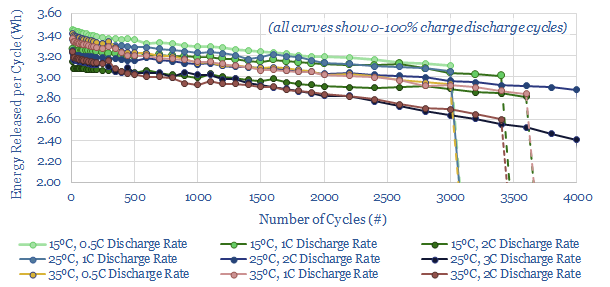We have aggregated and cleaned publicly available data into lithium ion battery degradation rates, from an excellent online resource, integrating 7M data-points from Sandia National Laboratory. Our data-file quantifies how battery degradation is minimized by limited cycling, slower charging-discharging, stable temperatures and LFP chemistries.
In the underlying laboratory studies that we have assessed, researchers have charged and discharged different batteries, across several thousand cycles, while measuring their capacity fade and round trip efficiencies. The goal is to understand how charging rates, state of charge, cycling conditions, temperatures and cell chemistry interact to determine battery degradation.
Battery lifespans range from 500 cycles to 20,000 cycles, depending on conditions.
The best conditions for long life spans of lithium ion batteries are using LFP chemistry, charging within a limited range, at low charge-discharge rates (C-rates) at a stable temperature of around 25C. This might be associated with a decline rate for batteries of around 2% per 1,000 cycles.
The fastest degradation rates for lithium ion batteries were seen in NCA chemistries, cycled from 0% state of charge to 100% state of charge, at high temperatures, and high discharge rates around 3C.
These lab studies show quite high variability, which is frustrating, as we would all like to pull out good rules of thumb for what drives battery degradation. But there is a fair degree of randomness in when a cell ultimately ‘fails’, as shown in the chart below, which aggregates the data on four different NMC cells tested under exactly the same conditions.

We have also tabulated other data into lithium ion battery degradation rates from technical papers that crossed our screen, as a useful reference, in case you are looking for aggregated data on the degradation rates of lithium ion batteries. Our notes on these technical papers are summarized in the final tab of the data-file.
Please note, this data-file does not contain any of the raw data from batteryarchive.org, which is free to download and to visualize from the underlying source. We draw out the implications of battery degradation data in our latest battery research, and in our broader battery research.

